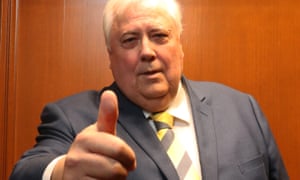Exclusive: analysis of 2019 federal election cash splash shows ads attacking Labor spiked in final week
Clive Palmer outspent McDonald’s, Toyota and Coles spruiking his United Australia party
in the year leading up to the federal election, and spent more than $8m
on saturation advertising in the final week of the contest, according
to new analysis obtained by Guardian Australia.
An assessment of Palmer’s extraordinary cash splash undertaken for Labor by an external consultant using industry standard analytics also indicates the controversial businessman changed his messaging strategy in the final week of the campaign, training a higher proportion of the spend on attack ads targeting the Labor party and Bill Shorten.
During April and early May, the United Australia party advertisements were focused predominantly on encouraging voters to support Palmer candidates, with a proportion of the spend devoted to criticising both of the major parties.
But in the week beginning 12 May, as undecided voters were firming up their voting intention, the focus of Palmer’s persuasion exercise changed.
Ads attacking Labor – which included “Shorten’s taxes will destroy Australian lives”, “Labor sold airport to China for $1”, and “tell shifty he’s dreaming” – increased significantly.
An assessment of Palmer’s extraordinary cash splash undertaken for Labor by an external consultant using industry standard analytics also indicates the controversial businessman changed his messaging strategy in the final week of the campaign, training a higher proportion of the spend on attack ads targeting the Labor party and Bill Shorten.
During April and early May, the United Australia party advertisements were focused predominantly on encouraging voters to support Palmer candidates, with a proportion of the spend devoted to criticising both of the major parties.
But in the week beginning 12 May, as undecided voters were firming up their voting intention, the focus of Palmer’s persuasion exercise changed.
Ads attacking Labor – which included “Shorten’s taxes will destroy Australian lives”, “Labor sold airport to China for $1”, and “tell shifty he’s dreaming” – increased significantly.
As the 2019 campaign entered its final weeks, according to Guardian Essential’s post-election review, more than a quarter of voters, 26% of the sample, were still on the fence about who to vote for. That number was down to 11% by polling day, with those voters making their decision on the day they cast their ballots.
If that sample was indicative of sentiment in the broader community, undecided voters broke decisively the Coalition’s way, particularly in the final week, when the Palmer spend – which amplified the Coalition’s negative messages about Labor’s high taxes – hit $8m. The cohort of voters who decided who to vote for on 18 May broke 38% for Scott Morrison and 27% for Shorten.
The Guardian Essential survey also showed voters were more conscious of negative messages about Labor and tax in the closing week of the contest than other issues, like climate change, which was also a vote-shifting issue.
The external analysis of the Palmer spend has been given to Labor’s campaign review, which is being undertaken by the former South Australian premier Jay Weatherill and former federal minister Craig Emerson. It only looks at advertising on television and radio. Palmer also ran significant outdoor advertising and digital campaigns, which are not captured.
The sections of the report seen by Guardian Australia show Palmer spent more than the major parties combined between early April and election day. It also shows the gap between what Palmer spent and what the major parties were spending widened in the final two weeks of the campaign.
In the final three weeks of the contest, Palmer spent $15m, the Coalition $6.3m, Labor $7m, and the ACTU close to $3m.
The analysis also indicates that conservative messaging during the 2019 campaign outgunned progressive messaging on television in all the metropolitan markets – Sydney, Melbourne, Brisbane, Adelaide and Perth – which was a marked shift from the 2016 contest.
The analysis assesses share of voice for television advertising in 2016 versus the conditions in 2019. In 2016 the share of voice between progressive and conservative political forces was roughly 50/50 in every market except Sydney, where the ratio was 39% progressive and 61% conservative.
In 2019, with the unprecedented Palmer spend in the mix, the ratio blew out to 75/25 in favour of conservative voices in all metro markets.
The report also cites Nielsen data showing the top advertising spenders in Australia between June 2018 and May 2019. The UAP was sixth on the list, with a spend of $67m – bigger than the banks, Sportsbet, Telstra, Bunnings, Coles, Toyota and McDonald’s. No other political party made it to the top 50.
Joo-Cheong Tham, the director of the Electoral Regulation Research Network at the Melbourne Law School, argues the Palmer case study in 2019 sets a new and troubling benchmark in the Australian political system.
“It appears the UAP spend in this election is the biggest campaign spending by a single party in the history of Australian elections, and I stress appears because what we have is a regulatory gap – the parties haven’t had to report since 1998 on their campaign expenditure,” he said.
“It points to the absence of spending controls in election campaigns.
“Even though UAP did not win a seat, it is clear the big spending had an important influence on the election outcome, and this is influence not by sheer force of ideas, or mobilisation in terms of people, but by money itself, and I think that undermines the fairness of the electoral contest”.
The Melbourne university professor, who is an advocate for caps on election spending for political actors and third parties, said the case study also pointed to the outsized influence of the fossil fuel industry on Australian elections.
He said it was self-evident that Palmer was a mining magnate, and electoral records show fossil fuel companies are among the largest contributors to the major parties.

No comments:
Post a Comment